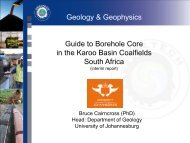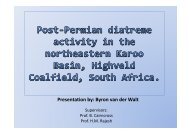coaltech upper olifants river catchment wetland inventory ...
coaltech upper olifants river catchment wetland inventory ...
coaltech upper olifants river catchment wetland inventory ...
Create successful ePaper yourself
Turn your PDF publications into a flip-book with our unique Google optimized e-Paper software.
6. DATABASE CONSTRAINTS<br />
The greatest problem was the lack of georeferenced aerial photographs for the area. Google<br />
Earth was investigated to determine if it would provide value to the project, but the quality of<br />
the images was too poor for the purpose of this project. The 1:50 000 aerial photographs, as<br />
obtained from the Chief Directorate: Surveys and Mapping at the Department of Land<br />
Affairs, Mowbray, Cape Town, was the only complete set of aerial photographs available<br />
for the site. The georeferencing of these aerial photographs was based on the 1:50 000<br />
topographical map and accuracy is therefore dependant on the accuracy of the topographical<br />
layers. In addition, all aerial photographs are skewed towards the edges due to the concave<br />
structure of the camera lens. We attempted to correct this feature during the georeferencing<br />
process, but the effect could not be removed completely. The <strong>wetland</strong>s located to the edges<br />
of the aerial photographs may therefore be slightly removed from their exact position.<br />
Where areas under cultivation were obviously located on a seepage area the <strong>wetland</strong> was<br />
indicated and the status of the <strong>wetland</strong> was given as E or F (destroyed). Some additional<br />
seepage areas covered by cultivation may occur, but have not been identified. This is<br />
because <strong>wetland</strong>s under cultivation are not easily distinguished. Patchiness in a cultivated<br />
area can be caused by a number of influences, including differences in soil and patchy<br />
distribution of fertiliser, in addition to the presence of seepage <strong>wetland</strong>s. Other highly<br />
disturbed <strong>wetland</strong>s may also not be identifiable on the aerial photographs as <strong>wetland</strong>s and<br />
these <strong>wetland</strong>s will be absent from the <strong>wetland</strong> layer. In addition, small <strong>wetland</strong>s are not<br />
visible on the 1:50 000 aerial photographs and are therefore not included.<br />
Tonal variations between the aerial photographs complicated the mapping of the <strong>wetland</strong>s on<br />
the aerial photographs. The changes from one strip of aerial photographs to another may be<br />
due to the time of day the photographs were taken and the light quality. Even without cloud<br />
cover the light quality may differ from day to day.<br />
7. COMPARISON TO THE NATIONAL LANDCOVER WETLAND LAYER<br />
The final Landcover <strong>wetland</strong> layer, completed in June 2006, was compared to the completed<br />
UORC <strong>wetland</strong> database. The Landcover <strong>wetland</strong> layer compared very well to the UORC<br />
<strong>wetland</strong> database, since all of the Landcover <strong>wetland</strong>s were already identified in the UORC<br />
database (Figure 20).<br />
Wetland Database for UORC - 89 -




